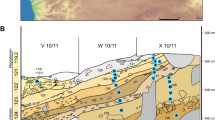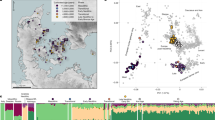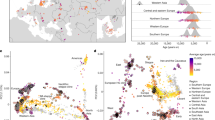Abstract
The archaeological site of Sagalassos is located in Southwest Turkey, in the western part of the Taurus mountain range. Human occupation of its territory is attested from the late 12th millennium BP up to the 13th century AD. By analysing the mtDNA variation in 85 skeletons from Sagalassos dated to the 11th–13th century AD, this study attempts to reconstruct the genetic signature potentially left in this region of Anatolia by the many civilizations, which succeeded one another over the centuries until the mid-Byzantine period (13th century BC). Authentic ancient DNA data were determined from the control region and some SNPs in the coding region of the mtDNA in 53 individuals. Comparative analyses with up to 157 modern populations allowed us to reconstruct the origin of the mid-Byzantine people still dwelling in dispersed hamlets in Sagalassos, and to detect the maternal contribution of their potential ancestors. By integrating the genetic data with historical and archaeological information, we were able to attest in Sagalassos a significant maternal genetic signature of Balkan/Greek populations, as well as ancient Persians and populations from the Italian peninsula. Some contribution from the Levant has been also detected, whereas no contribution from Central Asian population could be ascertained.
Similar content being viewed by others
Log in or create a free account to read this content
Gain free access to this article, as well as selected content from this journal and more on nature.com
or
References
Kuhn S : Paleolithic archeology in Turkey. Paleolithic archeology in Turkey 2002; 11: 198–210.
Cinnioglu C, King R, Kivisild T et al: Excavating Y-chromosome haplotype strata in Anatolia. Hum Genet 2004; 114: 127–148.
Vermeersch P, Öztürk I, Ekinci H et al: Late Palaeolithic at the Dereköy Karain Cave; in Waelkens M, Poblome J (eds): Sagalassos V Report on the Survey and Excavation Campaigns of 1996 and 1997. Leuven: Leuven University Press, 2000, pp. 451–462.
Ammerman A, Cavalli-Sforza LL : The Neolithic transition and genetics of populations in Europe. Princeton, NJ: Princeton University Press, 1984.
Renfrew C : Archaeogenetics: Towards a population prehistory of Europe; in Renfrew C, Boyle K (eds): Archaeogenetic: DNA and the Population Prehistory of Europe. Cambridge, UK: McDonald Institute for Archaeological Research, 2000.
Richards M, Macaulay V, Hickey E et al: Tracing European founder lineages in the Near Eastern mtDNA pool. Am J Hum Genet 2000; 67: 1251–1276.
Bellwood R, Renfrew C : Examining the Farming/Language Dispersal Hypothesis. Cambridge, UK: McDonald Institute for Archaeological Research, 2002.
Zeder MA : Domestication and early agriculture in the Mediterranean Basin: Origins, diffusion, and impact. Proc Natl Acad Sci USA 2008; 105: 11597–11604.
Edwards IES, Gadd CJ, Hammond NGL, Sollberger E : The Middle East and the Aegean Region, c.1800–1380 BC, 3 edn, Vol. 2. Cambridge, UK: Cambridge University Press, 2000.
Sahoglu V : The Anatolian Trade Network and the Izmir region During the Early Bronze Age, Vol. 24. Oxford, ROYAUME-UNI: Blackwell, 2005.
Waelkens M, Vanhaverbeke H, Martens F et al: The late antique to early Byzantine city in Southwest Anatolia. Sagalassos and its territory: a case study; in J. K, C. W (eds): Die Stadt in der Spätantike—Niedergang oder Wandel? Stuttgart, 2006, Vol 190, pp 199–255.
King RJ, Ozcan SS, Carter T et al: Differential Y-chromosome Anatolian influences on the Greek and Cretan Neolithic. Ann Hum Genet 2008; 72: 205–214.
Cruciani F, La Fratta R, Trombetta B et al: Tracing past human male movements in northern/eastern Africa and western Eurasia: new clues from Y-chromosomal haplogroups E-M78 and J-M12. Mol Biol Evol 2007; 24: 1300–1311.
Waelkens M : Sagalassos and Pisidia during the Late Bronze Age; in Waelkens M, Loots L (eds): Sagalassos V: report on the survey and excavation campaigns of 1996 and 1997. Leuven: Leuven university press, 2000, pp 509–549.
Oettinger R : Indo-germanische Sprachträger lebten schon im 3. Jahrtausend v. Chr. In Kleinasien (ed): Die Ausbildung der anatolischen Sprachen: Die Hethiter und ihr Reich. Volk der 1000 Götter Bonn, 2002, pp 50–55.
Waelkens M : Romanization in the East: A case study. Sagalassos and Pisidia (SW Turkey). Istanbuler Mitteilungen 2002; 52: 311–368.
Waelkens M : Ein Blick von der Ferne: Seleukiden und Attaliden in Pisidien. Istanbuler Mitteilungen 2004; 54: 435–471.
Russell J : Late ancient and medieval population. Transactions of the American Philosophical Society 1958; 48: 1–152.
Mitchell S : Anatolia:land, men, and gods in Asia Minor I, The Celts in Anatolia and the Impact of Roman Rule. New York: Oxford University Press, 1994.
Di Benedetto G, Erguven A, Stenico M et al: DNA diversity and population admixture in Anatolia. Am J Phys Anthropol 2001; 115: 144–156.
Berkman CC, Dinc H, Sekeryapan C, Togan I : Alu insertion polymorphisms and an assessment of the genetic contribution of Central Asia to Anatolia with respect to the Balkans. Am J Phys Anthropol 2008; 136: 11–18.
Zalloua PA, Platt DE, El Sibai M et al: Identifying genetic traces of historical expansions: Phoenician footprints in the Mediterranean. Am J Hum Genet 2008; 83: 633–642.
Zalloua PA, Xue YL, Khalife J et al: Y-chromosomal diversity in Lebanon is structured by recent historical events. Am J Hum Genet 2008; 82: 873–882.
El-Sibai M, Platt DE, Haber M et al: Geographical structure of the Y-chromosomal genetic landscape of the Levant: a coastal-inland contrast. Ann Hum Genet 2009; 73: 568–581.
Waelkens M, Paulissen E, Vermoere M et al: Man and environment in the territory of Sagalassos, a classical city in SW Turkey. Quaternary science reviews 1999; 18: 697–709.
Ricaut FX, Waelkens M : Cranial discrete traits in a Byzantine population and eastern Mediterranean population movements. Hum Biol 2008; 80: 535–564.
Cooper A, Poinar HN : Ancient DNA: do it right or not at all. Science 2000; 289: 1139.
Hofreiter M, Serre D, Poinar HN, Kuch M, Pääbo S : Ancient DNA. Nat Rev Genet 2001; 2: 353–359.
Pääbo S, Poinar H, Serre D et al: Genetic analyses from ancient DNA. Annu Rev Genet 2004; 38: 645–679.
Yang DY, Eng B, Waye JS, Dudar JC, Saunders SR : Improved DNA extraction from ancient bones using silica-based spin columns. Am J Phys Anthropol 1998; 105: 539–543.
Van Oven M, Kayser M : Updated comprehensive phylogenetic tree of global human mitochondrial DNA variation. Hum Mutat 2009; 30: E386–E394.
Vanhaverbeke H, Waelkens M (eds): The Chora of Sagalassos: The Evolution of the Settlement Pattern on the Territory of Sagalassos (Pisidia, SW Turkey) from Prehistory Until Recent Times. Turnhout, Belgium: Brepols, 2003.
Gilbert MTP, Bandelt H-J, Hofreiter M, Barnes I : Assessing ancient DNA studies. Trends Ecol Evol 2005; 20: 541–544.
Calafell F, Underhill P, Tolun A, Angelicheva D, Kalaydjieva L : From Asia to Europe: mitochondrial DNA sequence variability in Bulgarians and Turks. Ann Hum Genet 1996; 60: 35–49.
Comas D, Plaza S, Wells RS et al: Admixture, migrations, and dispersals in Central Asia: evidence from maternal DNA lineages. Eur J Hum Genet 2004; 12: 95–504.
Derenko M, Malyarchuk B, Grzybowski T et al: Phylogeographic analysis of mitochondrial DNA in northern Asian populations. Am J Hum Genet 2007; 81: 1025–1041.
Forster P, Cali F, Rohl A et al: Continental and subcontinental distributions of mtDNA control region types. Int J Legal Med 2002; 116: 99–108.
Kouvatsi A, Karaiskou N, Apostolidis A, Kirmizidis G : Mitochondrial DNA sequence variation in Greeks. Hum Biol 2001; 73: 855–869.
Quintana-Murci L, Chaix R, Wells RS et al: Where west meets east: the complex mtDNA landscape of the southwest and Central Asian corridor. Am J Hum Genet 2004; 74: 827–845.
Pruvost M, Schwarz R, Correia VB et al: Freshly excavated fossil bones are best for amplification of ancient DNA. Proc Natl Acad Sci USA 2007; 104: 739–744.
Brega A, Scacchi R, Cuccia M, Kirdar B, Peloso G, Corbo RM : Study of 15 protein polymorphisms in a sample of the Turkish population. Hum Biol 1998; 70: 715–728.
Tambets K, Kivisild T, Metspalu E et al: The topology of the maternal lineages of the Anatolian and Trans-Caucasus populations and the peopling of Europe: Some preliminary considerations; in: Renfrew C, Boyle K (eds): Archaeogenetic: DNA and the Population Prehistory of Europe. Cambridge, UK: McDonald Institute for Archaeological Research, 2000, pp 219–236.
Kosmetatou E, Waelkens M : The ‘Macedonian Shields of Sagalassos’, In Sagalassos IV. Report of the Survey and Excavation Campaigns of 1994 and 1995; in: Waelkens M, Poblome J (eds). Leuven: Leuven University Press, 1997.
Arndt A, Van Neer W, Hellemans B, Robben J, Volckaert F, Waelkens M : Roman trade relationships at Sagalassos (Turkey) elucidated by ancient DNA of fish remains. J Archaeol Sci 2003; 30: 1095–1105.
Bracke H : Pisidia in Hellenistic times (334-25 B.C.); in: Waelkens M (ed): Sagalassos I. First General Report on the Survey (1986–1989) and Excavations (1990–1991). Leuven: Leuven University Press, 1993, pp 15–29.
Bermisheva MA, Kutuev IA, Korshunova T, Dubova NA, Villems R, Khusnutdinova EK : Phylogeografic analysis of mitochondrial DNA Nogays: the high level of mixture of maternal lineages from Eastern and Western Eurasia. Mol Biol (Mosk) 2004; 38: 617–624.
Yao YG, Kong QP, Wang CY, Zhu CL, Zhang YP : Different matrilineal contributions to genetic structure of ethnic groups in the silk road region in China. Mol Biol Evol 2004; 21: 2265–2280.
Vanhaverbeke H, Başağaç Ö, Paul K : A Selçuk Hamam at Ağlasun (Burdur province). Turcica 2005; 37: 309–336.
Acknowledgements
We thank Maarten Larmuseau for critical reading and comments on earlier drafts of the present manuscript. This research was supported by the Belgian Programme on Interuniversity Poles of Attraction (IAP 6/22) and the Research Fund of the K.U.Leuven (BOF-GOA 07/02), next to projects G.0286.00 and G.0421.06 of the Fund for Scientific Research, Flanders (FWO). M Waelkens is one of the people who received a ‘Methusalem grant’ from the Flemish Ministry for Science Policy. The mtDNA sequences reported in this paper have been deposited in GenBank (Accession Numbers: HQ007946–HQ008051).
Author information
Authors and Affiliations
Corresponding author
Ethics declarations
Competing interests
The authors declare no conflict of interest.
Additional information
Supplementary Information accompanies the paper on European Journal of Human Genetics website
Rights and permissions
About this article
Cite this article
Ottoni, C., Ricaut, FX., Vanderheyden, N. et al. Mitochondrial analysis of a Byzantine population reveals the differential impact of multiple historical events in South Anatolia. Eur J Hum Genet 19, 571–576 (2011). https://doi.org/10.1038/ejhg.2010.230
Received:
Revised:
Accepted:
Published:
Issue date:
DOI: https://doi.org/10.1038/ejhg.2010.230
Keywords
This article is cited by
-
Archaeogenetic analysis of Neolithic sheep from Anatolia suggests a complex demographic history since domestication
Communications Biology (2021)
-
Whole mitochondrial genome genetic diversity in an Estonian population sample
International Journal of Legal Medicine (2016)



